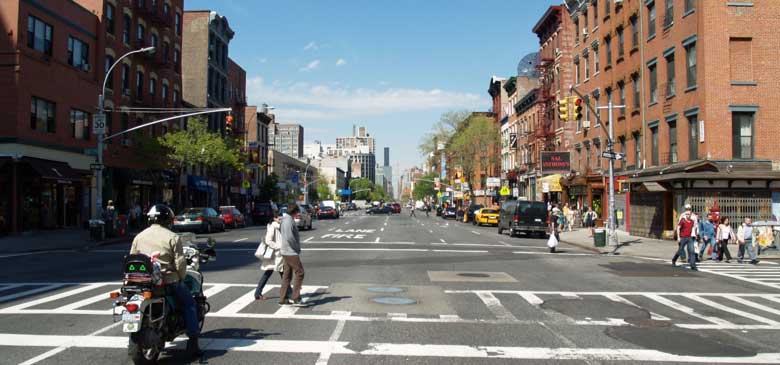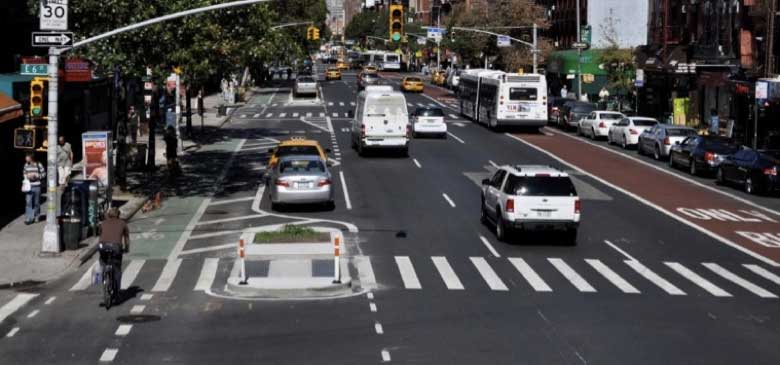As cities across California seek to build safer, healthier, greener “complete streets,” many have come into conflict with Caltrans over what constitutes an acceptable (and legally defensible) design. This post will be the first of a series in the coming weeks that examines issues of street design and how it impacts safety, particularly for vulnerable users such as bicyclists and pedestrians.
The design of our streets fundamentally engineers our driving behavior. A street with multiple wide lanes, few signals, and limited bicycle, pedestrian, and transit facilities encourages us to drive fast, whereas a street with narrow lanes, frequent signals, and prominent bicycle, pedestrian, and transit facilities encourages us to slow down and be more alert. In designing safe streets, speeding and lack of visibility are threats on par with distracted and drunk driving.
Caltrans’ Role in Street Design
The Caltrans Highway Design Manual has long been the standard to which California cities have designed their streets: it is legally required for cities to follow the manual for the design of bicycle facilities, and many cities default to the manual (along with A Policy on Geometric Design of Highways and Streets, otherwise known as the “Green Book,” by the American Association of State Highway and Transportation Officials, or AASHTO) for all aspects of roadway design. Cities were first required to follow the Caltrans manual in the infancy of bicycle facility design, before practices to deal with intersections and bike lanes had been developed. The Caltrans and AASHTO guides are also a convenient reference guide for other aspects of roadway design for cities, especially small- and mid-sized cities that haven’t developed their own guidance.
The Caltrans and AASHTO manuals are troublesome, however, in their application to urban (and many suburban) streets. Both manuals are rooted in decades of state highway engineering in which the primary objective is to move as many cars as efficiently and safely as possible for rural, intercity, and express transportation—areas in which a state transportation agency has jurisdiction. This focus is inherently automobile centric: they assume streets are for cars and do not focus on how to best serve other roadway users such as pedestrians, bicyclists, and transit riders.
In recent years, there has been some progress at modernizing the Caltrans manual to create a more people-centric, rather than car-centric document. In 2008, the California legislature passed AB 1358, the Complete Streets Act, which requires cities and counties to include complete streets policies as a part of their general plans to safely accommodate all road users. Caltrans has since adopted a complete streets implementation action plan, intended to modernize the agency and incorporate best practices for bicycle and pedestrian facilities.
Yet, even with some updates, Caltrans remains a major obstacle to innovation for cities across the state. A recent report commissioned by Governor Brown by the State Smart Transportation Initiative (SSTI) called out Caltrans’ “archaic” automobile-oriented standards and “culture of risk aversion and even fear” in preventing local jurisdictions from implementing modern bicycle and pedestrian designs. The report states: “Caltrans’ peculiar standards on bicycle facilities even pertain to locally owned streets, precluding some active transportation initiatives… The agency and department should support, or propose if no bill is forthcoming, legislation to end the archaic practice of imposing state rules on local streets for bicycle facilities.” The report demonstrates how ingrained the automobile-centric culture is within Caltrans, noting “one senior staff member… told us that bicycle and pedestrian facilities are not part of Caltrans’ mission.”
NACTO Design Guides Provide Alternatives to Caltrans, AASHTO
While progress toward safe streets remains slow at the state level, cities across the country are taking the lead. New York City, under the leadership of Mayor Michael Bloomberg and Transportation Commissioner Janette Sadik-Khan, has been the most prominent leader in fundamentally rethinking street design over the past five years. New York City aggressively implemented a number of transformative projects—from CitiBike to the pedestrianization of Times Square—but some of the most impressive (albeit less flashy) have been the redesign of its great boulevards and avenues. Consider the before and after photos of First Avenue below:
NYCDOT transformed a dangerous five-lane automobile-oriented thoroughfare and replaced it with a three-lane street with a parking-protected cycle track, a bus rapid transit lane, and shorter, more visible crosswalks. The impacts of this project for First and Second Avenues were far-reaching: injury crashes decreased by 37%, bicycle volumes increased by 177%, bus speeds increased by 18%, bus ridership increased by 12%, and commercial vacancies declined by 47%.
New York City is not alone in fundamentally rethinking its streets: many cities including San Francisco, Chicago, Portland, Seattle, and others have begun to undergo similar transformations. These cities, have banded together to form the National Association of City Transportation Officials (NACTO). Projects like the First and Second Avenue redesigns fundamentally deviate from what AASHTO or Caltrans (in CA) would allow, which necessitated the creation of a new design manual from cities DOTs, not state DOTs.
NACTO has produced two design guides: the Urban Street Design Guide and the Urban Bikeway Design Guide. The Urban Street Design Guide provides guidance on all aspects of building complete streets, including automobiles, transit, bicyclists, pedestrians, and stormwater management. The Urban Bikeway Design Guide focuses on areas of bike design guidance—particularly for cycle tracks—that AASHTO, Caltrans, and other manuals have failed to address. Cities across the country, including San Francisco and Oakland, have endorsed these guides as primary reference documents. We will examine them in greater detail in the coming weeks.
What’s Next for California Cities
Despite the ongoing innovations in safe street design codified in the NACTO guides, California cities remain hampered by the Caltrans manual, either by legally-binding bike guidance or an overall sense of risk aversion to go against traditional street design and traffic engineering orthodoxy. Some cities, such as San Francisco, continue to move forward despite the legal risk of unapproved bicycle designs. As CA Bike Coalition Executive Director Dave Snyder told the SF Bay Guardian “San Francisco is technically breaking the law because they have the best traffic engineers in the state and a good City Attorney’s Office and they know they can defend it in court if they have to,” Snyder said. ”Most places in the state won’t do that.”
The SSTI report makes several recommendations to modernize Caltrans, including:
- Caltrans should relinquish oversight of bike facilities on locally owned streets.
- Caltrans should give designers the option of using NACTO standards in metro areas.
- Caltrans should generally rethink its approach to facilities in metro areas and town centers.
One potential solution is already in the works: the legislature is presently considering AB 1193, which would require Caltrans to define and establish design standards for a new cycle track classification (Class IV). The bill could serve as a vehicle toward legalizing cycle tracks, or with a few amendments could lead to the adoption of the NACTO Bikeway Design Guide or relinquish Caltrans oversight over bicycle facilities altogether.
Creating safer streets begins at the city level, and other reforms are necessary including traffic models and eliminating Level of Service (LOS) requirements. Nevertheless, cities look to Caltrans for guidance in street design, and state highways such as San Pablo Ave, 19th Ave, and El Camino Real often represent key main streets in communities. A larger revamping of Caltrans is necessary to change the department’s automobile-centric culture and provide greater leadership in creating complete streets.



